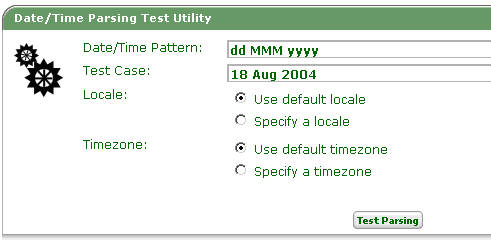|
Use the Date/Time Parse Tester tool to test whether a text input matches the DateTime patterns used by PRPC, which are based directly on Java standards.
Starting the tester
- Use the Class Explorer to open the standard activity Code-Pega-Parse.DTParseTester.
- Click the toolbar Run button (
 ). A test input form appears.
). A test input form appears. - Select No test page. Click Reset .
- Leave the parameter values blank. Click Execute .
- Complete the input fields on the form:
Field |
Description |
| Date/Time Pattern |
Enter a pattern. The count of pattern letters identifies a format:
For a comprehensive description of the syntax, see |
| Test Case |
Enter text that may contain a date or date/time formatted with the pattern. |
| Locale |
Select:
|
| Timezone |
Select:
|
6. Click Test Parsing .
7. The system searches the Test Case text for a conforming date or date/time value. If found, it converts the value into a PRPC internal format and displays the results.
Example



|
free text rules, locale |

|
Internationalization and Localization — Concepts and terms
Understanding the Date, Time of Day and DateTime property types |

 About the DateTime Parse Tester tool
About the DateTime Parse Tester tool http://icu.sourceforge.net/userguide/formatDateTime.html#sdf
http://icu.sourceforge.net/userguide/formatDateTime.html#sdf Tools — Other
Tools — Other